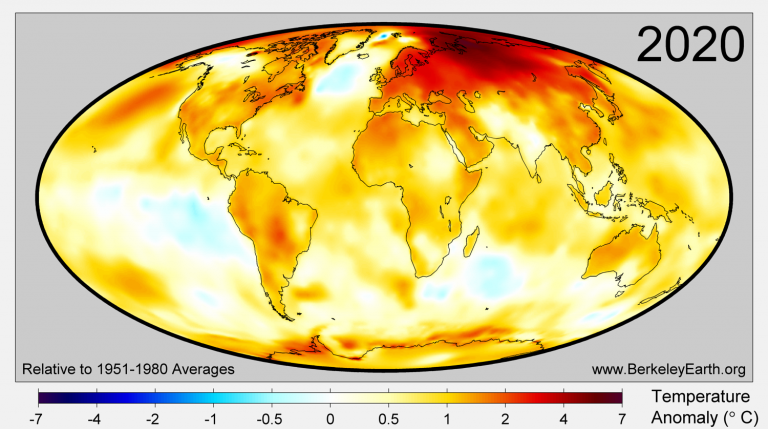On March 12 climate scientist Dr. Zeke Hausfather, Director of Climate and Energy for The Breakthrough Institute and research scientist for Berkeley Earth, was among several experts to offer testimony to the U.S. House of Representatives Committee on Science, Space, and Technology in a session titled “The Science Behind Impacts of the Climate Crisis.” This was the first time the committee addressed this topic, marking a significant milestone in the national conversation around global warming.

Since Berkeley Earth was established by Liz Muller and Richard Muller, co-founders of Deep Isolation, we are highlighting this important testimony in recognition of Earth Month 2021 and the 51st Earth Day. Deep Isolation recognizes that nuclear energy is an important means of addressing climate change, and without a nuclear waste solution, finding public support for nuclear may be challenging. The introduction to Hausfather’s testimony follows:
Good morning Chairwoman (Eddie Bernice) Johnson, Ranking Member (Frank) Lucas, and members of the Committee. I am grateful for the opportunity to join you today and the opportunity to share my perspective on the science behind the impacts of climate change. My name is Zeke Hausfather. I am the director of climate and energy at the Breakthrough Institute, an environmental think tank located in Oakland, California. I also serve as a research scientist with Berkeley Earth, and a contributor to Carbon Brief.
I am a climate scientist whose research focuses on observational temperature records, climate models, and mitigation technologies. I am also a contributing author to the IPCC 6th Assessment Report. My testimony today will draw upon my work and that of my colleagues to present a view of our changing climate and its impacts, the future warming pathways the world may take, the accelerating global energy transition away from carbon-intensive fuels, and the technologies needed to decarbonize the U.S. economy.
In many ways, 2020 was the year in which both climate change and the accelerating energy transition became impossible to ignore. On the climate front, we saw 2020 tie with 2016 as the warmest year since records began, with global temperatures around 1.3ºC (2.4ºF) above the temperatures of the late 1800s. Land areas – where we all live – were nearly 2ºC (3.6ºF) warmer. We saw devastating wildfires in California and Australia, extreme heat in Siberia, and the second-lowest level of Arctic sea ice ever observed, among other climate extremes.

At the same time, the world has made substantial progress in moving away from the worst-case outcomes of climate change over the past decade. Rather than a 21st century dominated by coal that energy modelers foresaw, global coal use peaked in 2013 and is now in structural decline. We have succeeded in making clean energy cheap, with solar power and battery storage costs falling 10-fold since 2009. The world produced more electricity from clean energy – solar, wind, hydro, and nuclear – than from coal over the past two years. And according to major oil companies peak oil is upon us – not because we have run out of cheap oil to produce, but because demand is falling as consumers shift to electric vehicles.
Current policies adopted by countries put us on track for around 3ºC (or 5.4ºF) of warming by the end of the century, compared to the late 1800s. Including pledges and targets – such as those included in the Paris Agreement – brings this down to 2.5ºC (4.5ºF). We have seen a proliferation of longer-term decarbonization commitments in recent years, with countries representing around half of global emissions – including China – pledging to reach net-zero by 2050 or 2060. If these longer-term commitments are achieved, it would bring end-of-century warming down close to 2ºC (3.6ºF).
Some caution is warranted here; long-term pledges should be discounted until reflected in short-term policy commitments. And warming could well be notably higher – or lower – than these best estimates, given scientific uncertainties surrounding both the sensitivity of climate to our greenhouse gas emissions and likely changes in the ability of the land and oceans to absorb a portion of what we emit. CO2 accumulates in the atmosphere over time, and until emissions reach net-zero the world will continue to warm.
This is the brutal math of climate change, and it means that the full decarbonization of our economy is not a matter of if but when. Cost declines in clean energy go a long way toward making deep decarbonization more achievable at a lower cost than appeared possible a decade ago. Low-cost renewables can provide a sizable share of our energy needs in modern grid-integration models. In the near term, however, America’s cheap and abundant supplies of natural gas will play a key role in filling in the gaps as we build out more wind and solar and keep existing clean energy sources like nuclear online.
In the longer term, there is a growing recognition of the need for both complementary technologies – such as grid-scale storage and long-distance transmission – as well as clean firm generation like advanced nuclear, enhanced geothermal, and gas with carbon capture and storage to wean the system off natural gas. Studies have consistently shown that low-carbon power grids with a sizable portion of clean firm generation are a lower cost option than wind, solar, and hydro alone.
Debates around climate mitigation are often framed as a choice between the technologies we have today and future innovations. In reality, we need to do both; to deploy what is cost-effective today, and to invest in the range of solutions needed to tackle the hard-to-decarbonize parts of the economy. The recent omnibus bill takes an important step in this direction, authorizing billions of dollars for investments in clean energy, vital energy R&D, and grid modernization. It shows that there is real potential for bipartisan energy solutions that both reduce emissions and create jobs.
If we want to ensure that the rest of the world follows the U.S. lead in reducing CO2 emissions, there is no better step that we can take than making clean energy technologies cheaper than fossil fuel alternatives. Making clean energy cheap can set the U.S. up to be a leader in developing and selling these technologies to the rest of the world while building new industries and creating jobs at home.
Find a link to the full testimony and a video of the hearing here.
